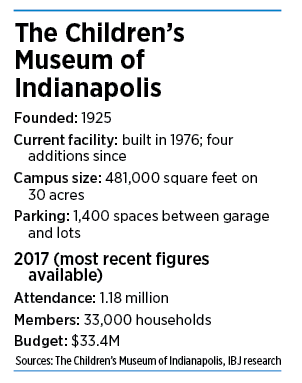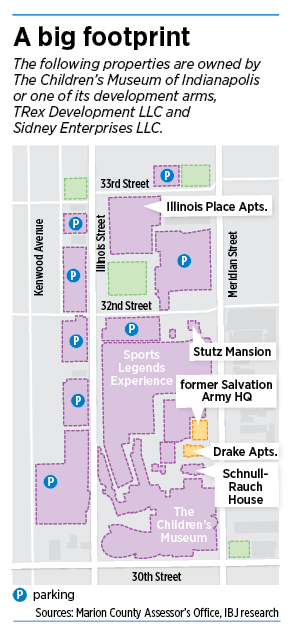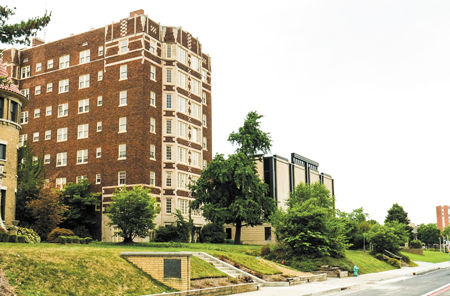Subscriber Benefit
As a subscriber you can listen to articles at work, in the car, or while you work out. Subscribe NowIndianapolis historic preservationists and midtown neighborhood leaders don’t want to lose the 91-year-old Drake apartment building on North Meridian Street that its owner, The Children’s Museum of Indianapolis, plans to raze in favor of more parking.
But can the Drake, which, according to Indiana Landmarks, “exhibits outstanding architectural character,” be saved?
Museum officials late last month announced demolition plans for the building, at 3060 N. Meridian St., as well as for the former Indiana divisional headquarters of the Salvation Army, next door at 3100 N. Meridian St. That 54-year-old building is not considered historically significant; both buildings are vacant.
Children’s Museum leaders say they went “to great lengths over 2-1/2 years to find a viable option for the properties in an effort to repurpose [or] save them,” including exploring partnering with a hotel management company to turn the Drake into a hotel, before deciding it was cost-prohibitive.

City officials say they are in talks with museum officials but warn that preservationists and neighborhood leaders have few levers to pull to save the eight-story Drake.
Michael McKillip, executive director of Midtown Indy, is one neighbor determined to find a way.
“You don’t have to look too far north and south of the Drake to see the legacy of demolition that has occurred on Meridian Street,” McKillip said. “We’ve lost many of the architectural gems. It would be a shame to lose the Drake in the same kind of manner.”
Some residents are calling for the museum to sell the building to a third party, such as the not-for-profit Indianapolis Neighborhood Housing Partnership, that would help redevelop it for affordable housing.
Others are calling for the museum or a development partner to move the structure to another lot.
The museum “would not be willing to sell the Drake property,” museum Vice President of Operations Brian Statz told IBJ in an email. “If someone came to us with a proposal to move the Drake to another location, we would be glad to discuss it.”
The building is adjacent to the Red Line bus rapid-transit line, which launches next month. INHP officials are eager to see affordable housing built along the Red Line, and they’ve purchased other properties near Meridian Street for that purpose.
INHP Vice President Joe Hanson said his organization is, indeed, interested, although he doesn’t know whether it could afford the necessary repairs.

In any case, he said, “if they’re not a seller, we can’t be the buyer. There’s not much we can do.”
‘A lost opportunity’
Historic preservation officials call the standoff unfortunate.
“To dispose of a property like that just seems incredibly wasteful and a lost opportunity,” said Marsh Davis, president of Indiana Landmarks. “I think the community would really like to see it saved.
“If [the museum] wants to make it happen, they can. The question is, do they want it to happen or not? I think the answer is pretty clear.”
Some preservationists say the city’s Indianapolis Historic Preservation Commission should designate the building a protected structure to save it from demolition—a move the commission’s leader says is on the table.
“Anytime we see a situation where a building that is an important structure is in danger, we’re going to look at all the different options that are available relative to protecting the building,” said IHPC President Bill Browne. “We’re moving into this methodically and carefully.”

An IHPC intervention would be a “rare” move—but it has happened, said Emily Mack, director of the Department of Metropolitan Development.
For example, in 2004, the IHPC stepped in to save the city’s second-oldest house, the Thomas Askren House, at 6550 E. 16th St. Two years later, it protected Meridian Street Methodist Episcopal Church, at 802 N. Meridian St., which paved the way for its conversion into condos.
The IHPC within the next month might vote on protecting the Drake, Browne said, but it’s also striving to reach a resolution that would make doing so unnecessary.
He said city and IHPC officials have met with museum officials and asked them to respond to “whether there’s still an opportunity to still look at saving the Drake or whether that ship has sailed from their standpoint.”
He added: “Hopefully, we’ll find a mutual decision that works.”
Others say they are resigned to the reality that the building will come down.

Leigh Riley Evans, director of the Mapleton-Fall Creek Community Development Corp., was part of a focus group convened by the museum to determine the property’s future. She said it was “definitely disappointing” that the museum decided to raze the property.
In the end, she said, “we are accepting of the choices that were made.”
“We talked about turning them into apartments, an office building, and we talked about making it a hotel,” Evans said. “We just could not find partners who had the financial capacity to make it happen.”
However, Mack said the city is open to offering the museum or a developer incentives to help make a project viable.
The path forward
Museum officials said they’ve already fully explored redevelopment options.
“We attempted to find interested apartment and hotel management companies to partner with—to no avail,” Statz said in an email.
“Half of the 10 companies did not respond at all. Four companies declined to submit a proposal, with some stating that the market would not support a hotel in this location. The one hotel proposal we received was reviewed thoroughly but unfortunately did not contain a financially viable plan.”
But Davis of Indiana Landmarks said he believes developers were interested in the building but that the museum RFP was so restrictive that it “pretty much [guaranteed] failure of the RFP process.”
Museum officials declined to provide a copy of the RFP.

Ed Battista, an Indianapolis developer and restaurateur, said the museum should move the Drake instead of razing it.
“If they want to put something [there] that will devalue the neighborhood like a parking lot, they should be required to pick that building up and move it to a better location,” Battista said.
“It’s an inspiring, really incredible building. It deserves to continue.”
According to Indiana Landmarks, the Drake is likely eligible for listing on the National Register of Historic Places.
The building is an “excellent example of the Collegiate Gothic style of architecture, commonly found on college campuses and built in the 1920s,” according to Mark Dollase, Indiana Landmarks’ vice president of preservation services.
On the first floor, numerous features survive, he said, including leaded and stained glass and the original elevator.
Some apartments still have fireplaces, and those on higher floors boast “expansive views,” he said.
‘Let go’
 Before the museum could demolish the building, it would need wrecking permits from the city’s Department of Business and Neighborhood Services.
Before the museum could demolish the building, it would need wrecking permits from the city’s Department of Business and Neighborhood Services.
So far, BNS spokesman Dimitri Kyser said, the museum has applied for only asbestos-removal permits, a precursor to demolition.
The department could deny the museum a wrecking permit if “project plans do not meet building codes and/or city ordinance regulations,” Kyser said, but not “based on subjective reasoning when all other guidelines and procedures have been fulfilled.”
Doug Day, a neighborhood activist, said he wanted to explore saving the Drake, but most preservation advocates don’t understand its level of disrepair.
According to the museum, experts it retained “believe the building needs a new electrical system, new plumbing system, new windows, and new elevators,” along with outside work—fixes that could cost millions of dollars.
“I toured the Drake and really liked it,” Day said, “but I’ve rehabbed a 140-year-old house myself, and I know that what you see wrong with it is probably less than half of what is really wrong with it.
“The scary part is what you don’t see. [The museum] is not in the apartment business.”
Day said it’s not realistic to believe every historic property can be saved.
“You’ve got to be judicious in what you try to save and what you let go,” he said.
But Browne of the IHPC said, “We have seen lots of buildings in a pretty deteriorated state be able to come back and be saved.”
With the help of city incentives, he said, “there’s a pretty reasonable likelihood you could make this building economically viable and feasible. It’s just a question of [whether] that fits in the Children’s Museum’s master plan.”
Parking lot?
Replacing the Drake with a parking lot adds insult to injury, several advocates said.

Battista called it “the grossest thing they could possibly put there.”
The museum has 1,400 parking spaces spread among its garage and surface lots. Officials said they haven’t determined how many spaces would go on the Drake and Salvation Army sites.
Eliminating the buildings frees up money now spent on insurance, utilities and maintenance.
And parking is only a short-term plan, museum officials stressed.
“In the long term, the museum may use the properties to enhance exhibits and programs, which are free to residents of the six neighborhoods surrounding the museum,” Statz told IBJ in an email.
Still, even a temporary parking use is concerning to neighbors.
A large Indianapolis institution acquiring adjacent properties to address parking needs “is not a new dynamic,” McKillip said. “But it’s one of the first times a building as significant, historic and beautiful as the Drake has given way to a parking lot.”
Because current zoning would not permit parking, the city could deny rezoning.
However, Mack said it’s too early to know how DMD staff and the Metropolitan Development Commission would respond to a request.
“I will say that both the [department] staff and the MDC value transit-oriented development, and we certainly would take that into consideration should anything be filed,” she said.
Jeffery Tompkins, a Ball State University urban planning student and blogger for “Indyimby,” which stands for “Yes In My Backyard,” said the city needs to seize opportunities to develop properties along the Red Line.
“There’s a limited amount of space along the Red Line corridor that has not been developed. If we have an apartment building with dozens of residents and shops, you’re actualizing that space, rather than allowing a low-level use like a parking lot or a gas station.”
He added: “Let’s start growing opportunities for people to be along this corridor. A surface parking lot says, ‘Hey, this exists for cars and not people.’”•
Please enable JavaScript to view this content.


I live at the Drake during the early 1970’s. The brass elevator and stained glass are great memories. It was a grand place, but even then it was getting rough around the edges. It’s just not practical to save everything; let it go.
I can accept the loss of the Drake. It sucks, but it is in severe disrepair. However, this entire process by TCM has made me skeptical and less than trusting (if they knew they couldn’t restore or preserve it, why buy it at all and why not sell it?).
What I cannot accept is a parking lot going in its place. That is a slap in the face to a marginalized neighborhood that has been gutted by tax-exempt institutions for more and more parking over the last several decades and is an insult to the investment that the City is making in transit.
Yes, it should be saved and no, the loss of the Drake is not acceptable. With hindsight being 20/20 and watching this unfold for the last few years, there is no way TCM ever planned on keeping this historic building.
It seems as if the RFP process was a sham to provide a cover story to the Museum’s plan from day one to demolish the building. When a building is vacant for as long as the Drake has been vacant, it is bound to deteriorate. The cost of renovation using tax credits and other creative financing can easily cover the renovation costs. There are affordable apartments several blocks further north on Meridian that were renovated for affordable apartments and there was no controversy about the cost of rehab. The Children’s Museum did not reach out far enough and long enough to save the Drake. They never intended to save it. If they wanted it saved they would not have purchased it in the first place.
Due to the architecture in the Historic District, Meridian has been called one of the “great streets in America.” Much of Meridian north of 38th Street has been ignored, and blighted neighborhoods line this central artery of our city. The Drake should be saved to enhance this area of Midtown. I don’t think affordable housing along the Red Line will improve neighborhoods. It seems this was the intention of short-sighted IndyGoers. The neighborhood cannot be restored to its former splendor, as planners want to develop affordable. or low income housing, along the main street of Indianapolis. Housing could be built near the Red Line but not on Meridian Street, but we Hoosiers don’t walk a block. This city does not enjoy a walking culture. The entire Red Line is a disaster.
Save the Drake!
Yes, The Drake should be saved and it can be saved. There is a market for market-rate apartments in Midtown, just ask Van Rooy. They are spending millions on a major renovation to the Buckingham and Balmoral, which is right across the street from The Drake. The Children’s Museum of Indianapolis has leveled enough properties on Meridian and we don’t need yet another parking lot.
In exchange for allowing parking on the site, allow TCM to move the Drake and transfer ownership to someone who will restore it as apartments or hotel.
They could move it to the former Winona Hospital site north of 32nd…the Museum owns the vacant ground at 32nd & Illinois.
You’re kidding right? Do you have any idea how cost prohibitive that would be?
Have you forgotten that the historic Ambassador apartment building was moved to make way for the Central Library expansion? It is twice the footprint of the Drake, and two stories shorter so greater weight/mass than the Drake.
And the solution is simple: make TCM pay for it if they want the parking lot that badly.
The Ambassador wasn’t moved. https://historicindianapolis.com/ambassador-apartments/
Love The Drake!
I hate the Drake.
I hate to love the Drake.
The Children’s Museum clearly never intended to restore the building. They have been bad actors in this process, and as such have lost their their reputation and the trust of the public.
Creating a new surface parking lot fronting the street should be illegal in Indianapolis in 2019. That is especially true for such a prime location. I know that it is against code in downtown. It should be against code at this location too.
The apartment building is beautiful. Study after study has shown that preserving historical buildings are a boon a City. The Drake must be saved. Tearing it down would be a loss economically, culturally and environmentally for Indianapolis.
I’m not too sure why people are so upset about this. You can’t preserve everything, and I’m sure this will not permanently be parking. I’d rather the site be land banked and shovel ready as a parking lot than a deteriorating apartment building.
It’s a tax-exempt institution. They have no incentive to make it anything other than a parking lot. Once it’s there, it is there forever. If they aren’t going to fix the Drake or redevelop the property, they need to be forced to sell it.
Over time I could easily see it turning into a museum expansion. I dont see what mechanism or logic would be used to “force” them to sell it.
The Owners of the Buckingham & Balmoral on the east side of Meridian Street immediatly across the street are spending a significant amount to relocate tenants and make major improvements to that property which was built about the same time. The improvements include ne electrical, plumbing and air conditioning. I’m sure the scope of needed improvements are about the same since the buildings are about the same age. Meridian streets always been the most important street in Indianapolis and should not lose significant landmark buildings only to be replaced with parking lots. The CM benefits greatly from its location on Meridian Street and will benefit from a successful Red Line.